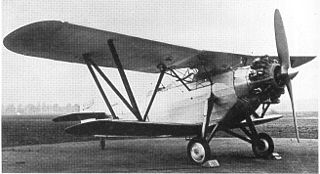
The Bristol Bulldog is a British Royal Air Force single-seat biplane fighter designed during the 1920s by the Bristol Aeroplane Company. More than 400 Bulldogs were produced for the RAF and overseas customers, and it was one of the most famous aircraft used by the RAF during the inter-war period.

The Fairey Hendon was a British monoplane, heavy bomber of the Royal Air Force, designed by Fairey Aviation in the late 1920s. The aircraft served in small numbers with one squadron of the RAF between 1936 and 1939. It was the first all-metal construction low-wing monoplane to enter service with the RAF.

The Short Springbok was a two-seat, all-metal reconnaissance biplane produced for the British Air Ministry in the 1920s. All together six aircraft of the Springbok design were built but none entered service with the armed forces.

The Gloster F.5/34 was a British fighter of the 1930s. It was a single-seat, single-engine monoplane of all-metal cantilever construction; the undercarriage was of the tailwheel type with retractable main wheels.

The Bristol Bloodhound was a British two-seat reconnaissance/fighter aircraft designed and built by the Bristol Aeroplane Company as a possible replacement for the Bristol F.2 Fighter for the Royal Air Force. It was unsuccessful, only four prototypes being built.

The Mitsubishi 2MR was a Japanese carrier-based reconnaissance aircraft of the 1920s, also known as the Navy Type 10 Carrier Reconnaissance Aircraft or the C1M in the Navy's short designation scheme. Designed for Mitsubishi by the British aircraft designer Herbert Smith, the 2MR was used by the Imperial Japanese Navy through the 1920s and 1930s.
The Morane-Saulnier AF, also known as the Morane-Saulnier Type AF and the MoS 28 was a French First World War single-seat biplane fighter prototype from 1917.

The Orenco D was an American biplane fighter aircraft, designed by Orenco and built by Curtiss Aeroplane and Motor Company. It was the first fighter type of completely indigenous design to enter US military service.

The Westland Wizard was Westland Aircraft's first attempt to produce a monoplane fighter. The project was privately funded and the prototype design was done in the spare time of the company's engineers. This all happened during 1926, with high-speed performance as the primary goal.

The Bristol Babe was a British-built light single-seat biplane, intended for the private flyer and produced immediately after the First World War. Only two flew.

The Bristol Type 118 was a general-purpose military aircraft, a two-seat biplane built by the Bristol Aeroplane Company in the early 1930s, powered by a Bristol Mercury radial engine and aimed at overseas markets. The Type 120 was a Bristol Pegasus-engined variant entered into an Air Ministry competition and later used for armament tests. Two aircraft were built.

The Bristol Type 123 was a single-seat, single-engine biplane fighter built to a United Kingdom Air Ministry specification for a four-gun fighter in the early 1930s. Only one was built.

The Bristol Type 146 was a British single-seat, eight-gun fighter monoplane prototype built to a mid-1930s Air Ministry contract. Powered by an aircooled radial engine, it was outclassed by Rolls-Royce Merlin inline engined fighters, and only one was built.

The Bristol Type 148 was a two-seat, single-engine low-wing monoplane built in 1937 to an Air Ministry specification for an army cooperation aircraft. It lost in the competition to the Westland Lysander and did not progress past the two prototypes that were built.

The Vickers Type 151 Jockey was an experimental low-wing monoplane interceptor fighter powered by a radial engine. It was later modified into the Type 171 Jockey II, which had a more powerful engine and detail improvements. Only one was built; it was lost before its development was complete, but the knowledge gained enabled Vickers to produce the more refined Venom.

The Westland F.7/30 was a British fighter prototype. A single prototype was built in 1934, but the type was not put in production because its performance fell far below the RAF's requirements. The Gloster Gladiator won the F.7/30 competition.
The Junkers T 23 was a two-seat, single-engined experimental training aircraft, built in Germany in the early 1920s. It could be configured either as a parasol winged monoplane or as a biplane to compare handling characteristics. 4 were constructed.

The Fokker PW-5 was a Dutch fighter aircraft of the 1920s. It was a parasol monoplane of which twelve were built for the US Army Air Service, being used as advanced trainers.
The Kondor E 3, sometimes erroneously known as E.III, was a German single seat, monoplane fighter aircraft designed and built close to the end of World War I. Though successful in the third D-type fighter competition at Aldershof in September 1918, only a few were produced, given the Idflieg designation of Kondor D.I.

The Mitsubishi 1MF10 or Mitsubishi experimental 7-Shi carrier fighter (七試艦上戦闘機) was a prototype Japanese monoplane single-seat carrier-based fighter aircraft of the 1930s. Two were built for the Imperial Japanese Navy, but both were lost in crashes, with no production following.

















